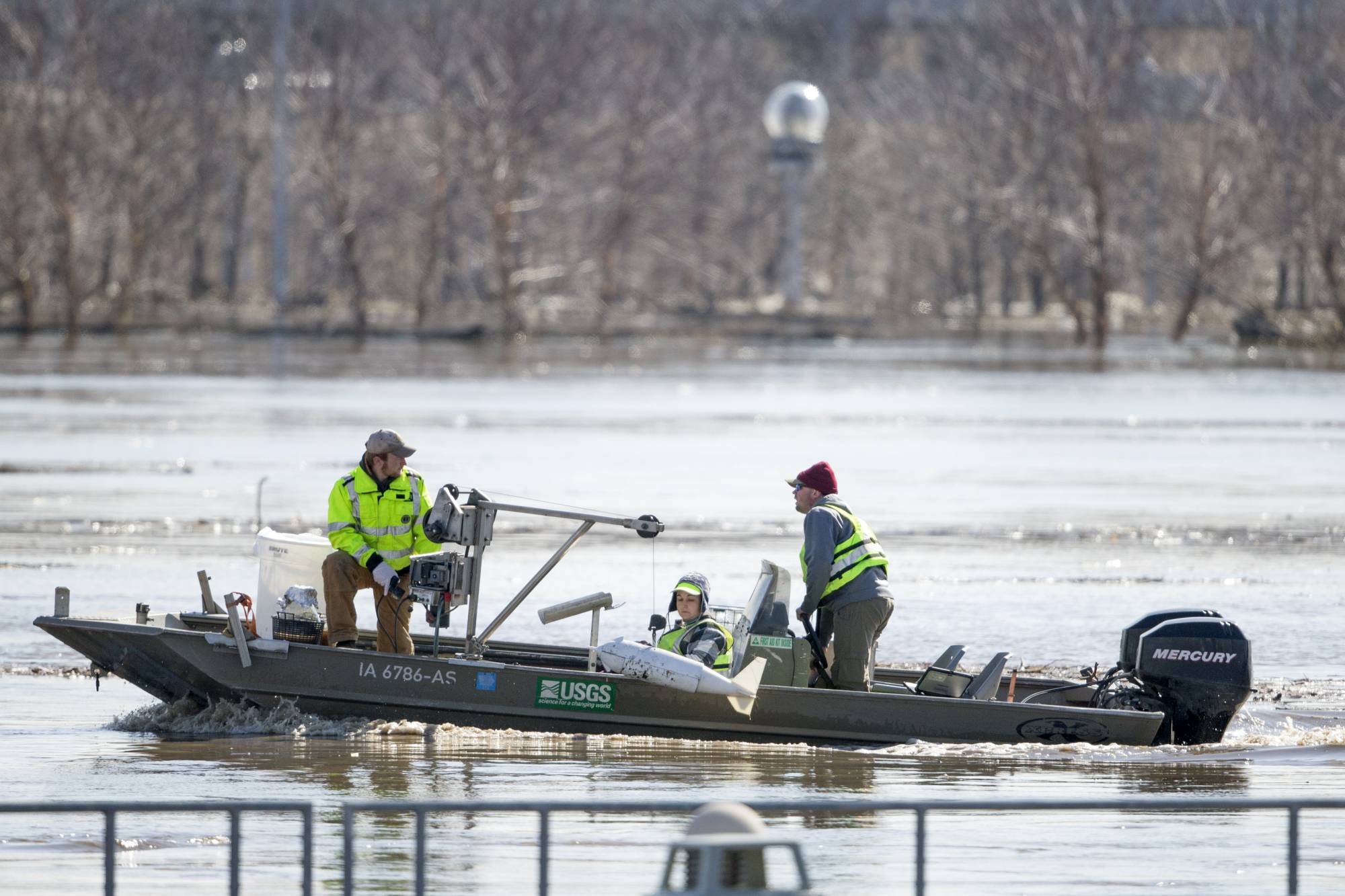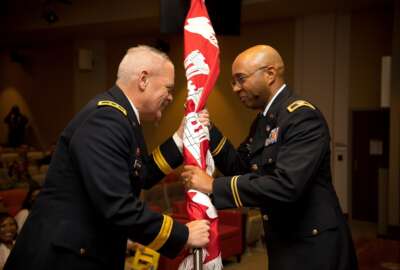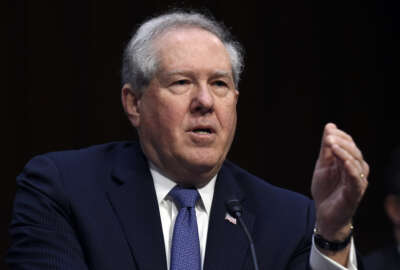
New ERDC commander at the Army Corp of Engineers
Lt. Col. Christian Patterson became the U.S. Army Corps of Engineers' Engineer Research and Development Center's first African-American commander. He spoke with...
Best listening experience is on Chrome, Firefox or Safari. Subscribe to Federal Drive’s daily audio interviews on Apple Podcasts or PodcastOne.
The U.S. Army Corps of Engineers’ Engineer Research and Development Center or ERDC, has a new commander. Following ERDC’s first ever female commander, the first ever African-American commander is now at the helm. Federal News Network’s Eric White spoke with the new man in charge: Lt. Col. Christian Patterson on the Federal Drive with Tom Temin.
Interview transcript:
Christian Patterson The U.S. Army Engineer Research and Development Center is headquartered in Vicksburg, Mississippi. We’ve got seven total laboratories. Four of them are on our Vicksburg campus and then we have three other laboratories that are in Hanover, New Hampshire; Alexandria, Virginia and Champaign, Illinois. In addition to that, we’ve got a field research facility in Duck, North Carolina, as well as a permafrost research tunnel facility in Fox, Alaska. In terms of our mission, what we do is we work to solve some of our nation’s most challenging problems in civil and military engineering; geospatial sciences; water resources [and] environmental sciences for the Army, for the Department of Defense, civilian agencies and for our nation and, of course, for the warfighter.
Eric White That is a wide footprint. Can you get any more specific on the kinds of projects that ERDC handles for the Army and the Army Corps of Engineers?
Christian Patterson You know, it’s an excellent question. It’s so vast. In my previous experience with ERDC, I served as the director of communications and it was a challenge to keep up with all of the cutting edge science and technology and research and development that’s going on with ERDC, because our researchers often have multiple projects. The way that I kind of describe it is exciting. What I mean by that is, it’s kind of like a Rubik’s Cube. Instead of having nine sides that you have to line up in terms of keeping up with all the great research, it’s like 100. Every single one of our projects is amazing [in] so many special ways, but just to kind of give you an example is we have an improve ribbon bridge project that I just saw the other day with our coastal and hydraulics laboratory. What they’re doing is working on a bridge that will allow for the next generation of tanks to be able to cross from one side to another safely and so looking at the model that they had in order to be able to test that was amazing. That’s something that’s very important for our warfighters in terms of safety, contributing to mission accomplishment down the road in the future. Other things that are going on that are pretty cool are we’ve got a lot of blast weapons effects testing that is ongoing, improved pavement operations that are going on as far as like pavement technologies for different types of aircraft to be able to land on and then also installation and operational environments is pretty cool. Making sure that the installations that we have in the future are energy friendly, that we use our water resources, everything as efficiently as possible, you know, for our soldiers and our servicemembers. And then at our permafrost research tunnel facility up in Alaska, they’re continuously studying the effects of climate change and microbes, for example. So are there microbes in the soil that could potentially harm us whenever permafrost melts? Some interesting research that’s going on there as well. And then I would like to invite you to take a look out on the web at our power of verdict podcast, and on there, we have a great episode about the supercomputing that we’re doing in order to help with the next generation engine for the B-52. Take a look at that, you’ll definitely hear some great in depth information about the research and development that we have going on with ERDC.
Eric White Yeah, with such a eclectic research, vast seems to be an understatement. How do you keep up with all that different kinds of research? And I guess we can use this to kind of segue into what you have planned for as now you are the commander of ERDC.
Christian Patterson Yes, keeping up is a challenge because like I said, it’s a lot of it. But our leadership is really good about keeping us informed in terms of what projects are out there, who were supporting in terms of those projects and also who we’re working with. One of the great things about ERDC is that we have a ton of relationships that are throughout the DoD, with interagency and with academia. That constant collaboration [is] always there in terms of our projects and everything. And you mentioned, what are my plans is commander, well the commander in ERDC is a part of a very big leadership team. Dr. David Pittman is actually the director of ERDC and he is the chief scientist for the U.S. Army Corps of Engineers, so he is the one that provides the vision for the research and development for our ERDC team. Where I come in is that I work shoulder to shoulder with him as the lead over what’s called the installation operations command. So all of those laboratories that I mentioned earlier, they have to have enablers, they have to have a force that help them to be positioned to do the world class research and development that we do. [We] work with our Resource Management Office, contracting, safety, Department of Public Works, so those type of offices that support the research and development so that we can make everything happen as far as benefiting the nation and the warfighter.
Eric White Is there a push to diversify the workforce within the STEM fields? You are the first African American commander of ERDC, your predecessor was the first female commander of ERDC. What ways do you think that you can, whether it’s your job personally or other initiatives that ERDC is taking to, have more women and minorities in the engineering field?
Christian Patterson You know, that’s something that we’re placing a very big focus on is to continue to grow as far as diversity, equity and inclusion. And you know, one of the things about Mississippi, and this is a good example of what we’re doing in order to get ahead in that area, is that we have a lot of historically black colleges and universities (HBCU). And so recently, we’ve done a lot of partnerships and visits in collaboration with Jackson State University, Alcorn State University, we’re in touch with Mississippi Valley State University up in Itta Bena, Mississippi. So we’re continuously building those relationships, not only with HBCUs, but we also have a strong relationship with University of Puerto Rico, Mayagüez and so we’re working in order to diversify our workforce for the future, because the way that we look at it is that those are diverse perspectives that are going to allow us to continue to make the research and development that we conduct even better down the road.
Eric White And let’s bring the focus back to you getting to this point in your career. Can you tell us a little bit about your background and how you made it this far?
Christian Patterson You know, it’s interesting, I am a communication focused person. And when I say communications is my focus, I’m going all the way back to speech and debate with, you know, the Byram High School speech and debate team back from 1990 to 94. And so I tell the story all the time about how my father actually made it happen to where I joined the Mississippi National Guard, and it wasn’t my choice. One day, he said, “Hey, Chris, you’re gonna join the National Guard next week.” And I was a senior in high school. And I was like, “Gee, Dad, thanks so much for making this important life decision for me.”
Eric White Okay.
Christian Patterson And so the next week came around, and you know, I tried to stay with my grandparents who lived in the same subdivision, so I would not be at home. But there was one day that I left something in my room and I said, “Okay, I’m gonna drive over there, literally be in 30 seconds, grab it and be gone.” Well, once I went in the house, literally 30 seconds and started to walk out, the recruiter was walking up the driveway. So I was trapped. And so we were in the living room, and he said, “Hey, I heard you’re interested in getting in the military.” And I said, “No, there’s nothing in the guard that I want to do.” And he’s like, “Well, what do you want to do?” I said, “I want to be a broadcast journalist. I want to be the next Rob J,” who, at the time, was a local sportscaster with our NBC affiliate in Jackson. He was kind of like the local version of Stuart Scott. And so he said, “You know what, Chris, we’ve got a unit that does that downtown across the street from the stadium. Why don’t you go and visit them just to see if you like it.” So I did and almost 29 years later, here I am. And so the amazing thing is that, from that point [I] deployed to Bosnia, deployed to Kosovo, deployed to Afghanistan. I got the chance to work with General Milley, Mark Milley, who’s the four star now and then General James McConville, who’s chief of staff [at the] Army, and outside of that it’s opened up some great opportunities working with Louisiana State University [LSU] football, and then you have ERDC. [I] was asked to come over and be the director communications three years ago. And a couple of months ago, I thought here at the end of my tour, I thought I was going back to the Mississippi National Guard, but then the command opportunity for ERDC opened up, and it was not something that was on my radar and every single day, I’m thankful to God for that opportunity, because it was bigger than anything that I could have imagined for my career. Dr. Pittman likes to say that ERDC is Disneyland for scientists, and it really is. We have some things that are going on there that are just truly amazing. Our employees are world class. We work together as a true team. And outside of that they wanted me to be able to tell the story. We have an awesome story at ERDC and Eric, we invite you to come down and take a look at it for yourself. Once you do you’ll be truly amazed. But we’d invite everybody to follow was on Facebook, visit our website and take a look at what we have going on because it doesn’t just benefit warfighters, we have things that are benefiting our entire nation and making things faster, cheaper, better and more efficient and better for our entire country down the road.
Tom Temin Lieutenant Colonel Christian Patterson is the new commander of the U.S. Army Corps of Engineers Engineer Research and Development Center, speaking with Federal News Network’s, Eric White.
Copyright © 2025 Federal News Network. All rights reserved. This website is not intended for users located within the European Economic Area.
Tom Temin is host of the Federal Drive and has been providing insight on federal technology and management issues for more than 30 years.
Follow @tteminWFED






